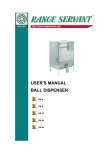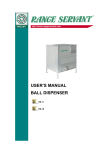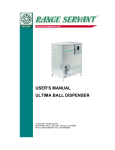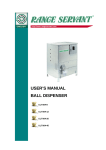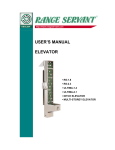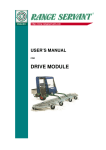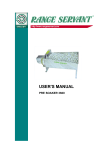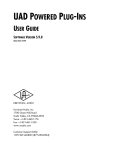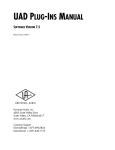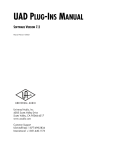Download USER`S MANUAL RS BALL DISPENSER
Transcript
ENGLISH http://www.rangeservant.com USER’S MANUAL RS BALL DISPENSER © Copyright, Range Servant 3000 Center Place - Suite 300 Norcross, GA 30093 Phone: (800) 878-8050 Fax: (770)448-8060 CONTENTS 1. 1 General information 1.1. 2. 3. -3- Preface -3- 1.2. Description 1.3.1 Ball Dispenser 1.3.2 Ball Management System -4-4-4- 1.3. Identification -4- 1.5 Technical specifications -5- Safety 6 2.1 General 6 2.3 Remaining risks 6 2.4 Authorised use 7 2.5 Unauthorised use 7 2.6 Emergencies 2.6.1 Fire 8 8 2.7 Operational reliability 8 How to use the Ball Dispenser 8 3.1 Necessary qualifications 8 3.2 BA-99 Control System 3.2.1 Introduction 3.2.2 Getting started 4. 9 9 9 Design and function 10 4.1. General 4.1.1 Machine exterior 4.1.2 Machine interior 5. 10 11 12 Maintenance 13 5.1. General 13 5.2. Maintenance intervals and instructions 13 5.3. Troubleshooting and repair 14 5.4. Function test 16 -1- 6. Installation 6.1. 7. 16 Factory testing and configuration 16 6.2. Installation of the ball dispenser Possible number of balls upon each payment 17 20 6.3. Installation – Wiring Diagram 6.3.1 Wiring Diagram for the connection of BA-99 to the Ball Dispenser 6.3.2 Wiring of Payment Systems Token 6.3.2.6,6.3.3.2 Power supply 21 21 22 22 22 Spare parts 22 7.1. External 7.1.1 External RS-4 7.1.2 External RS-8 7.1.3 External RS-12 7.1.4 External RS-20 7.1.5 External RS-45 7.2 Control box 24 24 25 26 27 28 29 7.2. Internal 7.3.1 Grid 7.3.2 Side view of grid inside the ball dispenser 7.3.3 Grid inside ball dispenser, viewed from above 30 31 31 32 Title: Prepared by: Date: Version: RS Ball Dispenser Manual Daniel Yenerall 05-29-2008 052908 -2- 1. 1 1.1. General information Preface We congratulate you to your new Range Servant machine. You have made a good choice! Not only have you chosen an excellent state-of-the-art Ball Dispenser with little demands on maintenance but you have also chosen quality. Quality is ensured with the help of modern production techniques, carefully chosen materials and the responsible workmanship of our staff. This User’s Manual contains all the information necessary to fully understand the maintenance and operation of the machine. Study the User’s Guide carefully before using the machine. If these instructions are not followed, persons using the machine might be injured or the equipment itself be damaged. In many cases, following the instructions is a necessary condition for Range Servants’ warranty to be applicable. Every person operating the machine must read these instructions. No part of this publication may be reproduced without the written authorisation of Range Servant. We offer a limited one-year warranty on our Ball Dispensers. This does not include payment systems and normal wear and tear. Study the warranty conditions carefully and keep them in a safe place. If you have any questions, or if problems should arise, please contact your Range Servant representative. ONE-YEAR WARRANTY Range Servant AB hereby undertakes to provide a warranty on material and function on the RANGE SERVANT dispenser for one year from the date of delivery. The guarantee does not cover payment systems and wearing parts. This engagement applies to repaired or replaced components for a period of three months. This undertaking only applies to the original purchaser. It also applies only to shortcomings of those parts, which the manufacturer verifies after due inspection. Repairs or replacement of parts may only be carried out by a representative authorised by the manufacturer. The manufacturer also guarantees that the equipment delivered matches the product description supplied. THE UNDERTAKINGS SPECIFIED IN THIS AGREEMENT CONSTITUTE THE MANUFACTURER’S SOLE OBLIGATION TOWARDS THE PURCHASER. THE MANUFACTURER IS IN NO WAY RESPONSIBLE FOR ANY UNDERTAKINGS OUTSIDE THE FRAMEWORK OF THIS WARRANTY CERTIFICATE. Neither is the manufacturer responsible for any undertakings given by any outside person during the sales negotiations. The warranty agreement does not apply to equipment that has been repaired or replaced by persons/companies not authorised by the manufacturer. The manufacturer’s warranty undertaking does not apply if the equipment is used incorrectly, if it has been damaged through improper maintenance or accidents or if it has been handled in a way not specified in the manual which is supplied with the dispenser upon delivery. The manufacturer is also free from financial liability for any type of injury that may arise in connection with the sale and repair of the equipment and from injuries to third parties in conjunction with its use. -3- 1.2. Description 1.3.1 Ball Dispenser The Ball Dispenser can be used either as a stand-alone machine or it can be integrated into a complete, automated system - the Range Servant Ball Management System. The user-friendly ball dispensers from Range Servant are designed to accept different types of payment and to deliver, quickly and consistently, the exact number of balls. Prices are differentiated and several payment methods can be used in parallel. The number of dispensed balls per payment can be easily changed by the user himself. The balls are handled with care and only undamaged and clean balls are delivered to the player. 1.3.2 Ball Management System Range Servant can deliver a complete, flexible Ball Management System adaptable to any kind of driving range requirements. The Ball Dispenser can be combined with the work-efficient, environment friendly Ball Washer. The Ball Washer in turn can be connected to the Elevator, the Conveyor Belt or the Blower for the transport of clean, undamaged balls from Washer to Dispenser. The system also includes a Ball Picker machine picking up used balls from all over the driving range. Thus the circle is closed and manual work reduced to a minimum. By applying our extensive know-how to the specific problems of every driving range we are able to offer tailor-made solutions. 1.3. Identification When contacting Range Servant, please identify your machine with the help of the information contained in the identification plate. The identification plate is well visible and firmly attached and contains the following information: • Name and address of the manufacturer • Designation of series or type of machine • Serial no., if any • Year of manufacture Fig. 1: Product identification plate -4- 1.5 Technical specifications General RS-4 Capacity [balls] Settings [balls/turns] Settings [turns/ payment] Water connection Min. water pressure [bar] /([psi]) Drain connection [mm] /([in]) Water consumption [L/turn] /([gal/turn]) RS-8 5 200 9-17 1-999 R 1/2" 1.96 (28.4) 75 (3) 0.5 (0.13) 8 000 9-17 1-999 R 1/2" 1.96 (28.4) 75 (3) 0.5 (0.13) RS-12* 12 000 9-17 1-999 - RS-20* 20 000 9-17 1-999 - RS-45* 43 000 9-17 1-999 - Dimensions: Height [mm] /([in]) Height with open lid [mm] /([in]) Width [mm] /([in]) Depth [mm] /([in]) Weight, with balls [kg] Weight, without balls [kg] 1476 (58.1) 1950 (76.8) 1012 (39.8) 550 (21.7) 760 (29.9) 462 648 88 95 110 2201 (86.7) 2022 (79.6) 1520 (59.8) 1112 XX 220 274 Electric system: Mains voltage (V, 60 Hz) Control voltage (V, DC) Effect, feeding motor (W) 120 12 70 120 12 70 120 12 70 Operating Conditions: +2 - +50 (+35- +122) Operating Temperature [°C] /([°F]) * Ball Washer and elevator not included Figure 2: Ball Dispenser RS-8. -5- 120 12 2x70 120 12 2x70 2. Safety 2.1 General Safety measures are a combination of measures taken by the manufacturer when designing and building the machine and measures that have to be taken by the user. The machine has been designed to function for its intended purpose. It has been designed and manufactured in such a way that configuration and maintenance can take place with the least possible risks to the operator, provided such work is carried out according to the instructions laid down in the User’s Manual. The objective of the safety measures is to eliminate all accident hazards during the operational life of the machine which also includes the assembly and dismantling of the machine, including any hazards arising as a consequence of such abnormal circumstances as can be anticipated. Accessories and spare parts that have not been approved by Range Servant can lead to personal injuries and/or equipment damage and affect the operational reliability of the machine. For the sake of safety you should therefore exclusively use accessories and original Range Servant spare parts recommended by Range Servant. Such accessories and spare parts are specially intended for the machine and are approved by us with regard to safety. All Range Servant retailers keep accessories and spare parts at your disposal along with competent advice. They also have the technical qualifications necessary for installing your machine and are informed about what technical changes are authorised. Damage caused by the use of accessories and spare parts not having been approved by Range Servant and damage due to unauthorised technical modifications are not covered by the warranty obligation. 2.3 Remaining risks There are warning signs serving as a reminder and warning to the user of any remaining risks, i.e. risks that we have not been able to eliminate, or sufficiently minimise, in our design and against which technical safety measures do not provide complete, or sufficient, protection. The warning signs shall be written in the local language and, on request, in the language understood by the respective operator. The signs are yellow with black characters. They are big enough to be readable from a distance of three meters. -6- Fig. 3: Warning signs on front hatch • Always disconnect the power supply to the machine before carrying out maintenance or service work. The mains switch is located in the control box in the lower right hand corner of the printed circuit board. DANGER! Don’t touch Risk of electric shock Fig. 4: Warning signs in control box • Never touch the circuit board or other electrical components in the control box. They can be current conducting and cause injury to person and/or equipment damage • Mechanical or electrical alterations may only be undertaken in consultation with Range Servant. 2.4 Authorised use The ball-dispensing machine may only be used for the distribution of golf balls. For the machine to operate properly, the balls must be clean and undamaged or else they may get stuck and cause machine failure. Distribution of balls may only start provided the machine has been installed according to the instructions contained in this Manual. 2.5 Unauthorised use Using accessories or spare parts not recommended by Range Servant might cause personal injury and/or equipment damage and affect the operational reliability of your ball dispenser. For safety reasons, use only those components recommended by us. They are intended for your machine, they have been chosen for safety reasons and they are approved by the manufacturer. Damage caused by the use of accessories and spare parts not having been approved by Range Servant or damage due to unauthorised technical changes are not covered by the warranty obligation. -7- 2.6 Emergencies 2.6.1 Fire Water shall be used as an extinguisher in the event of fire, except if the fire is located in the electric equipment, where a carbon dioxide extinguisher must be used. 2.7 Operational reliability For trouble-free operation and long service life the instructions below should be followed: • Place the ball-dispensing machine on a firm and level surface. • Place the machine under cover so that only the front is accessible to members of the public. If the machine is card-operated it must stand under cover for the warranty to apply. • Never strain the machine by loading it with more balls than recommended. The loading capacity for your machine is stated in the Technical Specifications at the end of the Manual. • The machine should be connected to its own wall socket to prevent interference with its electronic system. • Make sure that the electric box is always properly shut and covered when rinsing the machine. Moisture and water can damage the electrical components. • When cleaning inside the dispenser never spray water directly onto the electric motor. • By temperatures below 2°C the machine should be equipped with a warm air fan or, as the case may be, the water supply should be closed off, in order to avoid ice building up inside the ball dispenser. 3. How to use the Ball Dispenser 3.1 Necessary qualifications Due to the complex design and operation of the machine the person carrying out service and maintenance work must have the necessary qualifications. He is required to have attended a training course, in the form of a comprehensive study of the User’s Manual, followed by a written statement to the fact that he has well understood its contents. If the person has to be absent from work for more than three months, training has to be repeated. -8- 3.2 BA-99 Control System LO x 100 x 10 HI x 1 1 2 3 G IN + +12V RXD TXD GND G P1 G P2 G P3 G + R D + RESET ON 230 115 + B FUSE I ON WATER FUSE OFF DL DN DL DN IL IN SL SN 0 L N Fig. 5: BA-99 Control System 3.2.1 Introduction The BA-99 system has three payment channels marked P1-P3 allowing the user to choose between three different amounts of balls to be dispensed ranging from 1-999. The desired amount is selected with the help of the nine knobs located to the left of the terminal block G – P1-P3. More details are given in the following chapter “Getting started”. Payments can also be made during the dispensing process and will then be accumulated. A green LED marked ON is lit to indicate that power is on and a red LED marked DEP to indicate that payment has been registered and that the machine is prepared to dispense balls. The system is also equipped with a small circuit card consisting of two LED’s , a green and a red one, giving continuous information to the user. Green LED indicates that mains supply is on and red that payment has been made and that machine is in the process of dispensing. 3.2.2 Getting started The number of balls being delivered is determined by the number of turns made by the motor. With each turn of the motor a multiple of 9-17 balls is dispensed, see figure 25. You can decide yourself how many balls you wish the machine to dispense per payment as well as how many turns the machine shall make per payment. The Ball dispenser accepts different payment methods and you are free to decide whether the machine shall make the same number of turns for all the different payments methods or not. Connect the Ball Dispenser to the 230 VAC mains supply. -9- Adjust the ball dispensing knobs for the respective payment channel according to wish. Make your payment and check that the motor makes the correct number of turns and that the correct number of balls are dispensed. Example: Payment channel 1 2 turns x 100 = 0 x 10 = 2 x 1=3 x 100 x 10 x 1 1 2 3 Payment channel 2 4 turns x 100 = 0 x 10 = 5 x 1=4 Payment channel 3 12 turns x 100 = 1 x 10 = 2 x 1=8 4. Design and function 4.1. General The machine is intended for use as a golf ball dispenser. It consists of a ball magazine and is inside fitted with two plates on two levels for load reduction and, at the bottom, a grid. The grid consists of a number of ball ducts, arranged next to each other, the ends being joined to form a hinged ball cradle. The depth of the cradle corresponds to the size of a golf ball. Thus, with each swing of the cradle only the number of balls inside the cradle are delivered to the ball chute. All interior surfaces are inclined so that the balls are continuously flushed downwards. The lower level allows for damaged balls and debris to be sorted out. All essential parts of the Ball Dispenser are manufactured of stainless steel, rust protected steel or aluminium. The Range Servant Boll Dispenser has been designed in order to provide driving range owners with a long-lasting, reliable, practical and economic golf ball management system. - 10 - 4.1.1 Machine exterior Fig. 6: Outside front view Pos. 1 2 3 4 5 6 7 8 9 10 Designation Control box door Locks for control box, front hatch and lid Shackle, front hatch lock and lid Shackle, control box door Front inspection hatch Ball chute Front panel Front portion of lid Lid hinges Rear portion of lid - 11 - 4.1.2 Machine interior Fig. 7: Inside of the ball dispenser, side view Pos. 1 2 3 4 5 6 7 8 9 Designation Upper inclined plate Lower inclined plate Side plate of grid Grid Ball duct Ball chute Shock absorber Dispenser motor Control box - 12 - 5. Maintenance 5.1. General Maintenance carried out correctly minimises defects and ensures maximum service life and reliable operation. Any malfunctions are detected at an early stage and are therefore easily corrected. Regular maintenance minimises defects and equipment breakdown. The following maintenance instructions only refer to the most common problems and their causes. 5.2. Maintenance intervals and instructions Maintenance intervals: 1. After 300 operating hours 2. Once every month 3. Once every golf season Maintenance intervals and instructions 1 1.1 1.2 2 2.1 2.3 2.4 2.5 2.6 2.7 1 Machine exterior Lubricate the eccentric lock, the lid and front hatch locks and the hinges of lid and front hatch with ordinary lubricating oil. Lubricate the eccentric lock, the lid and front hatch locks and the hinges of lid and front hatch with ordinary lubricating oil. Machine interior: Tighten the fixation bolts of the grid. Lubricate the linking arms with ordinary lubricating oil. The collecting pan should be opened and cleaned regularly, to prevent grit and other debris from accumulating in the pan and gradually leading to corrosion and blockage. If chemical fertilisers are used on the driving range, we recommend that the dispenser is cleaned thoroughly once a month to prevent corrosion of the machine’s internal components. Cut the power supply to the machine, open the front hatch, remove grass and other debris and rinse with clean water. Empty the machine, sort out worn or damaged balls, stones and grit etc and clean the inside with normal clean water. (Do not spray water directly onto the electric motor.) Clean and dry the ball duct (located after the grid). - 13 - 2 3 X X X X X X X X 5.3. Troubleshooting and repair Although the operation of the machine is most reliable, problems may arise for various reasons. Attention! To reduce the time spent on troubleshooting, always start by checking that cables and connections are clean and tightened. Symptoms Possible fault Corrective measures The power supply is not connected. Connect the machine to the power supply. The ON/OFF switch on the circuit card is not "ON". Set the switch in the "ON" position. Defective fuse(s) on the circuit card. Replace the fuse(s) (2.5A/250V). Payment method is defective. Check the voltage with Ohmmeter. The voltage should fall from 5VDC to 0VDC when active. All payment methods must be NO (Normally Open). The Ball dispenser does not start. One payment channel is active. Measure the payment channel voltage and check that no channel is 0VDC. Fig. 8: Problem - the Ball dispenser does not start. The BA-99 control system requires at least one pulse from the micro-switch every ten seconds. Else the machine will make three quick starts and then close the feeding of balls. Symptoms Possible fault The micro-switch no. 105500 is not in the correct position or is stuck in closed position. The Ball Dispenser does not stop. Corrective measures Check that the micro-switch is correctly positioned and has not got jammed. The supply voltage to the machine varies. Connect the machine to a separate wall socket. The magnetic coil no. 10540 is defective. Check by disconnecting the automatic water feed. If the machine then works properly, replace the magnetic coil. Figure 9:Problem - the ball dispenser does not stop. - 14 - Symptoms The machine is running but does not dispense any balls. Possible fault Corrective measures The machine is not standing on a level and firm surface. Use a spirit level to check that the machine is level. The balls in the machine are dirty. Empty the machine of balls. Clean the machine inside and rinse well. Fill the machine with clean balls - that have been run through the Range Servant washer. There may be ice build-up in Machine. The ball cradle is jammed. If ice has built up, disconnect the water supply so that the machine is emptied of water. Make sure the ice has melted before using the machine again. Open the front hatch and remove the object jamming the cradle. The shock absorber is defective. Replace the shock absorber. The motor shaft is damaged. Replace the motor. Figure 10: Problem – no balls are delivered Symptoms The balls are not rinsed with water. Possible fault Corrective measures The machine is not equipped with water feed. Only models without the conical top are equipped with water feed (NOTE: not RS-4). The water supply has not been opened or it does not reach the machine. Connect the water hose to the machine and open the supply. The switch marked "WATER" on the circuit card is not in the ON-position. Set the switch to ON. The filter is clogged. Clean or replace the filter. The holes in the sprinkler arm are clogged. Clean or un-clog the holes with a drill. The magnetic coil no. 105400 is defective. Replace the magnetic coil. Figure 11: Problem – no rinsing water. - 15 - Symptoms Possible defect Token contacts do not close. Corrective measures Check the voltage with Ohmmeter. The voltage should fall from 5VDC to 0VDC when active (=closed position). The token switch must be connected in the NO position (Normally Open). Check that the token cable is not damaged or has stuck. The Ball Dispenser does not start. The (Mechanical) Coin Control switch does not close. See above re. token switch. The coin output of Electronic Coin Control Cashflow 340 is not activated. Activate coin output of Cashflow (acc. to 3.3.3.1 "Change of price, blocking of coins etc."). Measure payment channel with Ohmmeter. Voltage should fall from 5VDC to 0VDC when active. Check the price setting. The debits of the magnetic card reader EMC-30 do not appear in the display. EMC-30 debit indications appear on the display but the displayed number does not change and dispensing does There are no dispenses left on the card. Try a new card. Check that resistor 33k Ohm is not defective. Check that the mechanical switch of the reader unit is not closed. Figure 12: Problem – payment methods. 5.4. Function test After maintenance or repair work the operation of the machine should be tested by running the machine with the front hatch open. Insert a coin/token or payment card and check that everything works to satisfaction. 6. Installation 6.1. Factory testing and configuration The ball dispensers are always tested and configured before delivery to the customer. On this occasion all the parameters of the control system are adjusted according the customer’s wishes. - 16 - Our objective when carrying out this final check is to verify that the product corresponds on all accounts to the requirements laid down by the customer when ordering and to prevent defective products from being brought onto the market. 6.2. Installation of the ball dispenser For trouble free operation, place the ball dispenser on a firm and level surface. We recommend that the machine be located under cover and that only the front of the machine be accessible to members of the public. If the machine is card-operated, it must stand under cover according to the terms of the warranty. Place the ball dispenser on a firm and level surface. Remove the keys tied to the electric cable (see A) and remove the cable. ATTENTION! Don’t plug in the cable before the machine is ready to start. The keys are identical and are used for opening the control box (see B). Figure 13: Location of the keys on delivery Inside the control box there are another four keys, all identical, which fit the lid of the ball dispenser and the front inspection hatch. Figure 14: Location of keys in the control box. - 17 - Open the front inspection hatch and remove the package containing a plastic (PVC) pipe, a ball chute and the number of tokens you ordered for your machine. Fig. 15: Delivered material Place the plastic tray inside the control box so that the tokens fall straight into the tray. If the machine is both token and coin operated, there will be two trays for sorting both forms of payment at source. Fig. 16: Location of plastic tray. Push the waste water pipe into place over the pipe at the rear right-hand side of the bottom plate and rotate it to face in the appropriate direction. Connect the curved pipe to your existing drainage system. Use a ½" diameter hose to connect the water intake at the front right-hand side of the machine to a water tap, and turn the tap on full. The hose is not included with the machine. ATTENTION! Don’t plug in the cable before the machine is ready to start. Fig. 17: Water and drain connection. - 18 - Screw the ball chute into place over the hole at the bottom front plate of the machine. Screw the top nuts through the holes. Then screw in the lower nuts from underneath after first opening the collecting tray. Test a screw in each of the different holes on the front of the ball chute to find the best place to hang your ball buckets Fig: 18: Fastening the ball chute. Adjust the number of turns for the respective payment channels according to wish using the ball dispensing knobs as described in paragraph 3.2.2 “Getting started”. - 19 - You are free to determine the number of balls to be dispensed upon each payment. Block the number of ball ducts required to obtain the desired amount of balls to be delivered each time. This is done by adjusting the number of pins (A) along the horizontal retaining arm according to the adjoining drawing and place the enclosed plastic pipes (B) in the blocked ball ducts that is closed to the centre. Below is a table helping you to find out how many balls may be dispensed upon each payment. A B Fig. 19: Blocking of ball ducts Possible number of balls upon each payment Setting up number of balls on model RS-4/8/12/20/45 8 pins 7 pins 6 pins 5 pins 4 pins 3 pins 2 pins 1 pins no pin 1-turn 9 10 11 12 13 14 15 16 17 2- turn 18 20 22 24 26 28 30 32 34 3- turn 27 30 33 36 39 42 45 48 51 4- turn 35 40 44 48 52 56 60 64 68 5- turn 45 50 55 60 65 70 75 80 85 6- turn 54 60 66 72 78 84 90 96 102 7- turn 63 70 77 84 91 98 105 112 119 Fig. 20: Possible number of balls upon each payment - 20 - 8- turn 72 80 88 96 104 112 120 128 136 9- turn 81 90 99 108 117 126 135 144 153 6.3. Installation – Wiring Diagram To ensure safe and reliable operation, the control system must be correctly installed and grounded (earthed) and provided with good immunity against electronic noise. 6.3.1 Wiring Diagram for the connection of BA-99 to the Ball Dispenser LO x 100 x 10 HI x 1 1 2 3 Inductive gauge (Limit): G: switch (BLUE) G: Supply voltage limit (BLUE) IN: (BLACK) IN: Signal from limit switch (BLACK) G IN + +12V RXD TXD GND +: (BROWN) G P1 G P2 G P3 G + R D + + P-1 DISPGND + P-1 GND GND RESET ON Cable colours are indicated by (COLOUR) R, D, + are the contacts for the LED’s mounted in the door R: Supply voltage 230VAC is ON, green LED (GREEN) D: Dispensing in progress, redLED (BROWN) +: Supply voltage 12VDC to the LED’s (YELLOW) 230 115 + B Legend: LED’s FUSE RESET: Zeroing of microprocessor I ON WATER ON: Supply voltage 230VAC is ON 0 FUSE OFF DL DN DL DN IL IN SL SN L N DL: Water-valve 230VAC (BROWN) L: Supply voltage 230VAC (BROWN) DN: Water-valve 230VAC (BLUE) N: Supply voltage 230VAC (BLUE) DL: Dispensing motor 230VAC (BROWN) DN: Dispensing motor 230VAC (BLUE) Figure 21: Wiring of the ball dispenser models RS-4, RS-8, RS-12, RS-18, RS-20, RS-45. - 21 - 6.3.2 Wiring of Payment Systems Token LO x 100 x 10 HI x 1 1 2 3 G IN + +12V RXD TXD GND G P1 G P2 G P3 G + WHITE BROWN R D + RESET ON 230 115 + B FUSE I ON WATER FUSE OFF DL DN DL DN IL IN SL SN 0 L N Figure 22: Wiring of the Range Servant Token Control. The micro-switch for the token control must be connected as NO , Normally Open. 6.3.2.6 6.3.3.2 Power supply All machines can be supplied with 230/115 VAC +/- 10% 50-60Hz. 7. Spare parts In this chapter you will find detailed drawings of the ball dispenser showing the location of the different spare parts. The tables accompanying the drawings contain information about spare parts number and designation and the quantity of each spare part installed per machine model. - 22 - ( )= Optional accessories are marked with a parenthesis around the digit representing quantity. - = The alternative marked with ”-” depends on the customer’s choice of equipment. - 23 - 7.1. External Figure 23: External RS-4 7.1.1 External RS-4 Pos. 1 2 3 3 4 5 6 7 8 9 10 11 12 13 14 Part No. 186 600 DJM0046 166 700 150 500 101 890 101 950 151 101 101 800 102 100 OAA 0001 • 156 000 • 156 011 DJM0047 101 000 150 400 102 000 181 500 102 300 101 960 101 920 Designation Lid Lid hinges Lid retaining ribbon Side panel, right Pair of locks, with four keys Straight Latch Service hatch Front hatch Eccentric lock Waste-water pipe Collecting bowl Collecting tray Hinges, collecting tray Legs Side panel, left Ball chute Front panel Sign, RANGE SERVANT Bent Latch Spare key • Ball Dispenser with water - 24 - Quantity 1 2 1 1 1 2 1 1 2 1 1 1 2 4 1 1 1 1 1 Figure 24: External RS-8 7.1.2 Pos. 1 1 2 3 3 4 5 6 7 8 9 10 11 12 13 14 External RS-8 Part N0 186 600 186 500 DJM0046 166 700 180 500 101 890 101 950 101 100 101 800 102 100 • OAA0001 186 000 • 101 000 180 400 102 000 186 010 DJM0047 181 400 102 300 101 960 101 920 Designation Front portion of lid Rear portion of lid Lid hinges Lid retaining ribbon Side panel, right Pair of locks with four keys Straight latch Service hatch Front hatch Eccentric lock Waste water pipe Collecting bowl Legs Side panel, left Ball chute Collecting tray Hinges, collecting tray Front panel Sign, RANGE SERVANT Bent Latch Spare key • Ball dispenser with water - 25 - Quantity 1 1 1 1 1 1 2 1 1 2 1 1 4 1 1 1 1 1 1 1 Figure 25: External RS-12 7.1.3 Pos. 1 1 2 3 3 4 5 6 7 8 9 10 11 12 13 External RS-12 Part No. 101 900 101 960 101 920 180 500 101 890 101 950 101 100 101 800 102 100 186 010 DJM0047 101 000 180 400 102 000 181 400 102 300 117 000 Designation Lock with two keys Bent Latch Extra key Side panel, right Pair of locks with four keys Straight Latch Service hatch Front hatch Eccentric lock Collecting tray Hinges, collecting tray Legs Side panel, left Ball chute Front panel Sign, RANGE SERVANT Top • Ball dispenser with water - 26 - Quantity 2 1 1 1 1 1 2 1 1 4 1 1 1 1 1 Figure 26: External RS-20 7.1.4 Pos. 1 1 2 3 3 4 5 6 7 8 9 10 11 12 13 External RS-20 Part No. 101 900 101 960 101 920 120 500 101 890 101 950 101 100 101 800 102 100 186 010 DJM0047 102 000 101 000 120 400 121 400 102 300 127 000 Designation Lock with two keys Bent Latch Extra key Side panel, right Pair of locks with four keys Straight Latch Service hatch Front hatch Eccentric lock Collecting tray Hinges, collecting tray Ball chute Legs Side panel, left Front panel Sign, RANGE SERVANT Top • Ball dispenser with water - 27 - Quantity 2 2 1 2 2 2 4 2 2 2 4 1 1 1 1 Figure 27: External RS-45 7.1.5 Pos. 1 1 2 3 3 4 5 6 7 8 9 10 11 12 13 14 15 16 External RS-45 Part Nr. 101 900 101 960 101 920 120 500 101 890 101 950 101 100 101 800 102 100 186 010 DJM0047 102 000 101 000 120 400 121 400 102 300 736 610 737 000 720 500 720 400 Designation Lock with two keys Bent Latch Extra key Side panel, right Pair of locks with four keys Straight Latch Service hatch Front hatch Eccentric lock Collecting tray Hinges, collecting tray Ball chute Legs Side panel, left Front panel Sign, RANGE SERVANT Lid Top Side panel, right Side panel, left - 28 - Quantity 2 2 1 1 2 2 4 2 2 2 4 1 1 1 1 1 1 1 7.2 Control box Fig. 28: Control box Pos. 1 1 2 3 4 5 6 7 8 9 Part. No. 109410 109400 108600 101920 930235 101900 101960 - Designation Token collecting tray, small Token collecting tray, large Token monitor Spare keys Printed circuit board BA-99 Coin monitor Token slot Lock Bent Latch Control box door - 29 - RS-4 RS-8/12 RS-20/45 1 (1) 1 1 1 1 1 1 (1) 1 1 1 1 1 1 (1) 1 1 1 1 1 7.2. Internal Figure 29: Cross section Pos. 1 2 2 3 3 4 4 5 6 7 8 9 Part No. Designation 102610 Upper inclined plate 152701 Lower inclined plate 102701 Lower inclined plate 154002 Side plate of grid 184002 Side plate of grid 153700 Grid 103700 Grid 183200 Ball duct 102000 Ball chute 104404 Shock absorber 105601 Dispensing motor Control box RS-4 1 1 2 2 1 1 1 1 1 * Quantity per side - 30 - RS-8/12 RS-20/45* 1 1 1 1 2 2 2 2 1 1 1 1 1 1 1 1 1 1 7.3.1 Grid Figure 30: Grid viewed through the open front hatch 7.3.2 Side view of grid inside the ball dispenser Pos. 1 2 3 4 5 6 7 8 9 10 11 12 13 14 • • • • • • • Part No. Designation 109 200 105 600 184 400 104 300 104 800 104 900 105 000 105 100 105 200 105 300 DAM0002 103 900 104 700 105 500 125 500 DAM0000 Capacitor 15 µF Motor 120V Shock absorber Lever Water hose Hose clamp Hose nippel Dirt sieve Double nippel Water valve 120V Motor supporting plate Sprinkler arm Micro-switch holder Micro-switch 14CE2-3 Micro-switch, left Eccentric with cam 15 • Ball dispenser with water * quantity per side - 31 - RS-4/8 RS-12 RS-20/45* 1 1 1 1 1 1 1 1 1 1 1 1 1 1 1 1 1 1 1 1 1 1 1 1 1 1 1 1 1 1 1 1 1 1 Figure 31: Grid viewed from above 7.3.3 Pos. 1 2 3 4 5 5 76 87 8 9 Grid inside ball dispenser, viewed from above Part No. Designation 104 650 184 600 51 000 • 183 800 183 700 153 700 104 510 104 500 104 130 184 100 RS-4 Ball bearings Ball cradle 6x65 cotter pins as end stops Drip seal Grid Grid Linking spindle, left-hand thread Linking spindle, right-hand thread Roller brush flange Roller brush • Ball dispenser with water • quantity per side - 32 - 3 1 8 1 1 1 1 1 1 RS-8/12 RS-20/45* 3 1 8 1 1 1 1 1 3 1 8 1 1 1 1 1

































